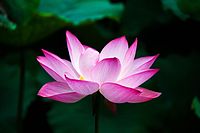
Photo from wikipedia
Abstract Most orchids have high ornamental value with long-lived flowers. However, the mechanisms by which orchids maintain floral longevity are poorly understood. Here, we hypothesized that floral longevity in Dendrobium… Click to show full abstract
Abstract Most orchids have high ornamental value with long-lived flowers. However, the mechanisms by which orchids maintain floral longevity are poorly understood. Here, we hypothesized that floral longevity in Dendrobium is maintained by high resource investment and complementary water and nutrient utilization in different structural units of the perianth. To test this hypothesis, we determined which water- and nutrient-related traits are correlated with flower longevity in 23 Dendrobium species or cultivars, and examined variations of the related traits during flower development of one long-lived cultivar. We found that floral longevity was correlated with dry mass per unit area of perianths and total flower biomass, which indicates that maintaining floral longevity requires increased resource investment. During development of long-lived flowers, labella showed a high capacity for water storage and nutrient reutilization, which could partly remedy high water demand and biomass investment. Sepals and petals, in contrast, had stronger desiccation avoidance and higher metabolic activity with lower biomass investment. These findings indicate that Dendrobium flowers maintain longevity by complementary water and nutrient utilization strategies in the sepals, petals and labella, with labella consuming more water and nutrients to extend flower display, and sepals and petals using a more conservative strategy.
Journal Title: Journal of Experimental Botany
Year Published: 2022
Link to full text (if available)
Share on Social Media: Sign Up to like & get
recommendations!